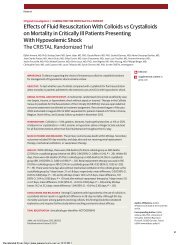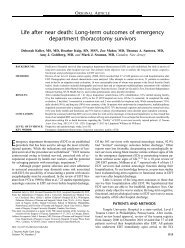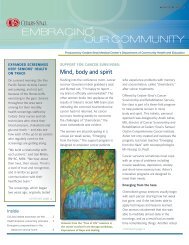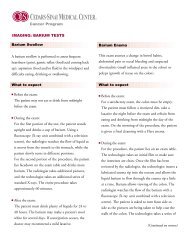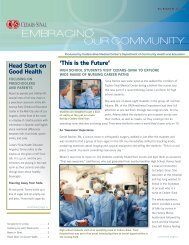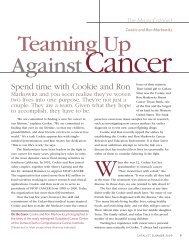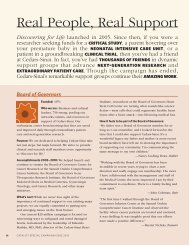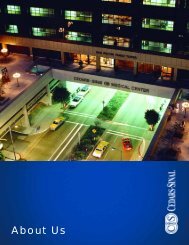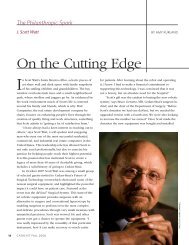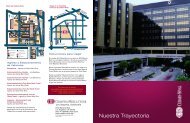800 CEDARS 1 - Cedars-Sinai
800 CEDARS 1 - Cedars-Sinai
800 CEDARS 1 - Cedars-Sinai
You also want an ePaper? Increase the reach of your titles
YUMPU automatically turns print PDFs into web optimized ePapers that Google loves.
8700 Beverly Boulevard, Los Angeles, CA 90048<br />
1-<strong>800</strong>-<strong>CEDARS</strong>-1 www.cedars-sinai.edu<br />
hi-res<br />
CEDA-00-012
2000 Report to the Community<br />
Leading the Quest for Health
Our Mission<br />
<strong>Cedars</strong>-<strong>Sinai</strong> Health System, a non-profit, independent health care organization, is committed to:<br />
■ Leadership and excellence in delivering quality health care services,<br />
■ Expanding the horizons of medical knowledge through biomedical research,<br />
■ Educating and training physicians and other health care professionals, and<br />
■ Striving to improve the health status of our community.<br />
Quality patient care is our priority. Providing excellent clinical and service quality, offering compassionate<br />
care, and supporting research and medical education are essential to our mission. This mission is<br />
founded in the ethical and cultural precepts of the Judaic tradition, which inspire devotion to the art<br />
and science of healing, and to the humanistic treatment we give to our patients and staff.<br />
Chairman’s & President’s Message<br />
page 1<br />
Medical & Nursing Leadership Message<br />
page 2<br />
Clinical Care & Research<br />
page 4<br />
Medical Network<br />
page 10<br />
Community Outreach<br />
page 13<br />
Facilities<br />
page 17<br />
Contributions<br />
page 19
Chairman’s & President’s Message<br />
From an institutional standpoint, the year that opened the<br />
new millennium marked a period of great progress for<br />
<strong>Cedars</strong>-<strong>Sinai</strong>, during which major long-range plans formulated in<br />
the prior year began to come to fruition.<br />
Four plans of significant importance were finalized and<br />
approved by the Board of Directors during 1999:<br />
■ The Health System’s Strategic Plan for the years 2000-<br />
2004, designed to be a high-level “road<br />
map” for the organization;<br />
■ A long-range Financial Plan to<br />
guide operations and help allocate our<br />
financial resources;<br />
■ A plan to extend the Medical<br />
Center’s major fund-raising initiative,<br />
Campaign for the 21st Century, into a<br />
second phase with a $360 million goal to<br />
fulfill the $500 million goal set for the campaign; and<br />
■ A master plan for “Building for the 21st Century”, the<br />
<strong>Cedars</strong>-<strong>Sinai</strong> facility expansion and renovation program to provide<br />
a state-of-the-art campus for the practice of leading-edge medicine.<br />
In 2000, these plans were activated, ensuring that all new<br />
and on-going efforts within our organization are well-coordinated<br />
Steven D. Broidy, Chairman of the Board<br />
and purposeful, soundly financed, and contribute significantly<br />
to our mission: to provide our community with the very highest<br />
level of health care available anywhere. The pages of this annual<br />
Report to the Community furnish considerable detail on the<br />
advances and accomplishments for which the strategic, financial,<br />
fund-raising, and facilities plans provided such a solid foundation.<br />
At this time when our country as a whole enjoys a sense<br />
of economic well-being, the climate for<br />
hospitals and other providers of health care<br />
is not so uniformly favorable. In this<br />
difficult financial climate, <strong>Cedars</strong>-<strong>Sinai</strong> has<br />
experienced not only institutional stability,<br />
but remarkably, significant growth.<br />
We firmly believe that the organization’s<br />
constant self-assessment and continual<br />
planning are instrumental to this<br />
unprecedented success. In “leading the quest for health,” our theme<br />
supporting our commitment to high quality, state-of-the-art<br />
health care, you can be assured that in the coming years, we will<br />
continue to assess and plan constantly, adjusting our efforts<br />
accordingly, so that we are always in the best position possible<br />
to provide unequalled care to our patients and our community.<br />
Thomas M. Priselac, President and CEO
Medical & Nursing Leadership Message<br />
At <strong>Cedars</strong>-<strong>Sinai</strong>, our first priority has always been, and<br />
will continue to be, to improve and enhance the high<br />
quality of care that our patients receive. This commitment to<br />
quality improvement is overriding, and permeates every aspect<br />
of our organization. It has led to the creation of a whole<br />
series of interlocking action groups<br />
and committees that take their lead<br />
directly from <strong>Cedars</strong>-<strong>Sinai</strong>’s Board of<br />
Directors and President and CEO,<br />
Thomas M. Priselac. Their charge goes<br />
far beyond regulatory requirements,<br />
encompassing all that can be done to<br />
assure that our patients receive the<br />
highest level of care possible.<br />
Our commitment to quality<br />
patient care includes not only taking immediate corrective<br />
action when a problem occurs, but also, identifying potentially<br />
problematic situations ahead of time and taking preventive<br />
action so these situations never arise. And the commitment also<br />
includes listening to patients themselves. <strong>Cedars</strong>-<strong>Sinai</strong> has<br />
participated in patient satisfaction initiatives for many years,<br />
and in the year 2000 has joined with hospitals throughout the<br />
page 2 Medical & Nursing Leadership Message<br />
state in PEP-C, a patient satisfaction survey whose results will be<br />
announced in 2001.<br />
Such intense concentration on the quality of patient care<br />
has resulted in recognition of <strong>Cedars</strong>-<strong>Sinai</strong>’s excellence, both from<br />
within the health care industry, and from outside evaluators. Just<br />
a few of the major honors received in<br />
the past 12 months are:<br />
■ <strong>Cedars</strong>-<strong>Sinai</strong> was designated a<br />
Magnet Nursing Service hospital by the<br />
American Nurses Credentialing Center.<br />
The prestigious magnet hospital award<br />
has been bestowed on just 19 of the<br />
nation’s 5,000 medical institutions.<br />
■ <strong>Cedars</strong>-<strong>Sinai</strong> has been re-accredited<br />
a Level One Trauma Center and a<br />
Pediatric Critical Care Center, the only private hospital in<br />
Los Angeles County with both of these designations. Level<br />
One is the highest classification attainable.<br />
■ A hallmark of excellence for a biomedical research<br />
program is the amount of federal funding that it receives. <strong>Cedars</strong>-<br />
<strong>Sinai</strong> laboratory and clinical research conducted through the<br />
Burns & Allen Research Institute receives more than 50 percent
of its funding from federal grants, a remarkably<br />
high percentage.<br />
■ U.S. News & World Report listed three<br />
<strong>Cedars</strong>-<strong>Sinai</strong> specialties among its “America’s Best<br />
Hospitals” rankings, which list only the top 50<br />
institutions in the country in each category. These<br />
were cardiology/cardiac surgery, gynecology and<br />
digestive orders.<br />
■ Recent survey results by the Pacific Business<br />
Group on Health ranked the <strong>Cedars</strong>-<strong>Sinai</strong><br />
Medical Care Foundation tops in Los Angeles for<br />
overall quality of care, overall patient satisfaction,<br />
thoroughness of treatment, doctors’ communication<br />
skills and preventive care counseling.<br />
Such honors notwithstanding, our top<br />
priority for the years ahead will continue to be to<br />
raise the level of <strong>Cedars</strong>-<strong>Sinai</strong> patient care higher<br />
still. We are proud to work with the fine team<br />
of physicians, professional and support staff,<br />
and volunteers in “leading the quest for health”<br />
at <strong>Cedars</strong>-<strong>Sinai</strong>.<br />
Paul B. Hackmeyer, M.D.<br />
Chief of Staff<br />
Michael L. Langberg, M.D., FACP<br />
Sr. Vice President for Medical Affairs<br />
Chief Medical Officer<br />
Linda Burnes Bolton, DR. P.H., R.N., FAAN<br />
Vice President and Chief Nursing Officer<br />
Shlomo Melmed, M.D.<br />
Sr. Vice President for Academic Affairs<br />
Professor and Director, Burns & Allen<br />
Research Institute<br />
Stephen C. Deutsch, M.D., FACP<br />
Medical Director, <strong>Cedars</strong>-<strong>Sinai</strong><br />
Medical Care Foundation
Clinical Care & Research<br />
Ahealth care organization firmly based in the community,<br />
<strong>Cedars</strong>-<strong>Sinai</strong> is also an academic medical center where<br />
future generations of physicians, nurses and other caregivers are<br />
trained, and where world-class biomedical research takes place both<br />
in the laboratory and via clinical trials. This unique, multi-pronged<br />
approach to medicine translates to<br />
superior care for our patients.<br />
With the complexity and sophistication<br />
of medical care increasing<br />
rapidly, the trend in health care today is<br />
toward an intense degree of teamwork.<br />
Thus, several recently formed <strong>Cedars</strong>-<br />
<strong>Sinai</strong> centers and institutes are multidisciplinary,<br />
representing collaborations<br />
of numerous clinical and service departments<br />
and divisions. Another trend, particularly visible in the<br />
cancer field, is to organize care around specific disease sites — at<br />
<strong>Cedars</strong>-<strong>Sinai</strong>, the formation of centers for prostate cancer and<br />
another for breast cancer are two good examples. By having all<br />
aspects of diagnosis and all the treatment modalities available<br />
in one location at the same time, the patient benefits.<br />
page 4 Clinical Care & Research<br />
Given the depth and breadth of <strong>Cedars</strong>-<strong>Sinai</strong>’s sophisticated<br />
programs and services, it would be impossible to list all of the<br />
year’s significant medical achievements and research discoveries.<br />
The listing below is a representative sampling.<br />
Anesthesiology – The Anesthesiology Pain Center has<br />
dramatically expanded its ability to<br />
deliver therapies with the addition of<br />
two fluoroscopy procedure rooms.<br />
Cancer –Many disciplines come<br />
together for the diagnosis and treatment<br />
of the more than 100 types of cancer.<br />
Outstanding progress includes:<br />
In bone marrow transplantation<br />
(BMT), the number of allogeneic transplants<br />
and the quality of treatment<br />
received has substantially increased.<br />
The newly opened Saul and Joyce Brandman Breast Center,<br />
a project of Women’s Guild, offers state-of-the-art care to women<br />
with breast cancer. The Center is unique in having been designed<br />
with input from breast cancer survivors.<br />
The new Prostate Cancer Center makes it possible for men
to be diagnosed and to consult with specialists in all the treatment<br />
modalities in a single, convenient location. Research into the<br />
effectiveness of new cancer-fighting drugs and drug combinations<br />
conducted there will improve future treatment options.<br />
The Gilda Radner Ovarian Cancer Detection Program has<br />
reorganized to focus on the highest risk women — those with an<br />
inherited BRCA gene mutation. Past findings have helped to shape<br />
current NIH recommendations for ovarian cancer screening.<br />
Myeloma treatment has been expanded with the recruitment<br />
of a well-known authority in that field.<br />
The advanced capabilities of the Department of Radiation<br />
Oncology were enhanced by augmenting the enormously precise<br />
equipment that delivers radiation treatment. This now includes<br />
three linear accelerators capable of IMRT (intensity modulated<br />
radiation therapy), and special equipment to allow interstitial<br />
implantation into regions not previously performed (such as<br />
the lung), for treating skin cancer patients, and for stereotactic<br />
radiation for bone malignant and benign brain tumors.<br />
Women’s cancer researchers are conducting 25 clinical<br />
trials for ovarian, uterine, cervical and vulvar cancer patients.<br />
Pediatric cancer researchers are conducting clinical trials<br />
involving acute lymphocytic leukemia, acute meloid leukemia,<br />
brain tumors, bone cancer, soft tissue sarcomas, neuroblastoma,<br />
Wilms tumor, Hodgkin’s disease and lymphomas as well as<br />
biology and genetic studies into the cause and treatment of cancer.<br />
“The electrophysiology research team demonstrated<br />
for the first time how certain drugs can work on<br />
the electrical properties of heart tissue and abort<br />
life-threatening disturbances of heart rhythm.”<br />
— Glenn Braunstein, M.D.<br />
Chairman, Department of Medicine<br />
In the basic science laboratory, investigators have discovered<br />
transferrin receptor 2, one of the proteins that allows iron<br />
(essential for normal cell growth) to get into cells, and whose<br />
over-expression can lead to malignancy.<br />
Cardiology/Cardiothoracic Surgery – <strong>Cedars</strong>-<strong>Sinai</strong><br />
heart care was rated the best in Southern California, and second<br />
in the state, by U.S. News & World Report.<br />
The Medical Center is the first site in California to perform<br />
a new FDA-approved therapy called LDL apheresis to treat patients<br />
Clinical Care & Research page 5
“In July, surgical teams performed the first<br />
double lung/liver transplantation in the western<br />
United States, giving a patient with cystic<br />
fibrosis a new lease on life.”<br />
— Achilles Demetriou, M.D., PH. D.<br />
Chairman, Department of Surgery<br />
with severe hypercholesterolemia, or extremely elevated bad<br />
cholesterol that doesn’t respond to medication, diet and exercise.<br />
The Cardiovascular Intervention Center performed the<br />
first septal ablation in Southern California for treatment of<br />
hypertrophic obstructive cardiomyopathy. This non-surgical<br />
approach has a rapid recovery time.<br />
The use of radial arteries (instead of the veins in the legs)<br />
for bypass surgery has been perfected, significantly decreasing<br />
symptoms and length of patients’ stay.<br />
The capabilities of the Advanced Heart Failure &<br />
Transplantation Program were expanded with recruitment of<br />
a surgeon specializing in the installation of artificial heart<br />
pumps known as VADs (ventricular assist devices).<br />
Emergency Medicine – More than 78,000 patients now<br />
receive treatment in the Emergency Department annually, an<br />
average of 215 a day. This vast experience has allowed the<br />
department’s researchers to contribute to the field through such<br />
page 6 Clinical Care & Research<br />
studies as a comparison of emergency medicine systems in<br />
36 countries, and another on the causes and effects of paramedic<br />
traffic diversion in a large urban system.<br />
Endourology Institute – A pioneer in the field of<br />
endourology has been recruited and has initiated a highly<br />
successful Endourology Institute. A major innovation is<br />
laparoscopic donor nephrectomy, a far less invasive procedure<br />
than ever before available that greatly facilitates<br />
living liver donation.<br />
Imaging –The S. Mark Taper Foundation<br />
Imaging Center and Department, known for<br />
the sophistication of its imaging capabilities, has<br />
a successful positron emission tomography (PET)<br />
scanning program, and has also implemented a<br />
picture archiving and communication system<br />
(PACS). Among many research accomplishments<br />
was a demonstration that combined assessment<br />
of heart muscle blood flow and heart muscle<br />
pumping function from routine nuclear<br />
cardiology studies. This procedure enhances non-invasive<br />
identification of patients at risk for serious cardiac events.<br />
Gastroenterology – <strong>Cedars</strong>-<strong>Sinai</strong> was ranked among<br />
the 50 best hospitals in America for digestive disorders by
U.S. News & World Report. Based on the recent discovery here of<br />
a key mechanism by which food is transported through the<br />
gastrointestinal system, a new therapeutic approach has been<br />
developed to slow the speed of transit to optimize nutrient<br />
absorption. Other productive lines of research have led to improved<br />
diagnostic and therapeutic approaches to Crohn’s disease,<br />
irritable bowel syndrome and fibromyalgia.<br />
Liver Disease –The <strong>Cedars</strong>-<strong>Sinai</strong> Hepatology<br />
Program and Division of Neurology have been<br />
recognized internationally as one of three U.S.<br />
Centers of Excellence in Wilson’s disease.<br />
Medical Genetics – Among the many<br />
significant genetic discoveries made by teams<br />
of <strong>Cedars</strong>-<strong>Sinai</strong> investigators are:<br />
Demonstration that insulin resistance<br />
is genetically related to hypertension and<br />
identification of a chromosomal location for<br />
a major contributing gene.<br />
Significant findings that provide a basis<br />
of understanding of mitochondrial mutations, responsible for<br />
such human diseases as neuromuscular disorders, deafness,<br />
blindness, cardiomyopathies, diabetes, skin lesions, aplastic<br />
anemia, Parkinson’s disease and aging in general.<br />
Publishing of major genome mapping resources that will<br />
aid in the detection of cancer/genetics breakpoints. These will be<br />
included in the similar resource about to be published by the<br />
National Cancer Institute and Human Genome Project.<br />
Neuroscience – One of the most prestigious research prizes<br />
awarded by the NIH has been presented to the director of the<br />
Maxine Dunitz Neurosurgical Institute. Major strides have<br />
been made by the Division of Neurology in elucidating the<br />
mechanisms underlying neurodegeneration.<br />
Nursing – The Nursing Services Department completed its<br />
Millennium Nursing Strategic Plan, a blueprint for attracting and<br />
retaining the most qualified nurses in the United States to provide<br />
quality care to <strong>Cedars</strong>-<strong>Sinai</strong> patients and the community. Included<br />
is the launching of an endowment for nursing practice and research.<br />
Obstetrics & Gynecology – Both clinical and research<br />
advances were made during the year 2000:<br />
The Department opened a Lactation Education Center,<br />
providing new mothers with guidance on the benefits of<br />
“We are proud to be recognized for the excellence of<br />
<strong>Cedars</strong>-<strong>Sinai</strong> gynecology, including obstetrics, by being<br />
ranked third in the entire state and 25th in the nation in<br />
U.S. News & World Report’s ‘America’s Best Hospitals’.”<br />
— Lawrence Platt, M.D.<br />
Chairman, Department of Obstetrics & Gynecology<br />
Clinical Care & Research page 7
eastfeeding, as well as training and support during the entire<br />
period that they breastfeed their infants.<br />
The 10,000th chorionic villus sampling (CVS) was<br />
performed by faculty of the Division of Maternal-Fetal Medicine,<br />
a landmark achievement in light of the test’s importance in<br />
diagnosing birth defects. Using CVS, advances in prenatal<br />
therapy permit parents to prepare for a safe birthing, and makes<br />
it possible to treat some birth defects even before birth.<br />
In conjunction with other world-renowned centers of<br />
obstetrical research, <strong>Cedars</strong>-<strong>Sinai</strong> has been studying the sensitivity<br />
of a first-trimester screening for Down’s syndrome and certain<br />
other chromosomal abnormalities. Preliminary results of the<br />
testing demonstrate a Down’s syndrome detection rate as high<br />
as 90 percent.<br />
“A unique new program developed with the<br />
Department of Medicine for long-term treatment<br />
of individuals with inherited, life-threatening<br />
hypercholesterolemia utilizes new technologies to<br />
allow selective removal of cholesterol from their blood.”<br />
— Stephen A. Geller, M.D.<br />
Chairman, Department of<br />
Pathology & Laboratory Medicine<br />
page 8 Clinical Care & Research<br />
Ophthalmology –Ophthalmology researchers continue<br />
to make exceptional contributions to the field, with major<br />
discoveries published in prestigious biomedical journals.<br />
Pathology & Laboratory Medicine – New tests for<br />
disorders in blood clotting that identify mutations on three<br />
different genes were developed and implemented for routine<br />
diagnosis. The renal biopsy service continues to serve large numbers<br />
of patients throughout the Southwest and remains<br />
the busiest of any hospital in the country.<br />
Pediatrics –The Division of Primary Care<br />
Pediatrics expanded its school-linked health care<br />
program to four schools in the Los Angeles<br />
Unified School District, serving more than 2,500<br />
low-income children. A new pediatric child<br />
development program serves children with<br />
developmental and behavioral programs.<br />
Pharmacy Services –The department<br />
received the first- and second-place National<br />
Hospital Pharmacy Quality Awards, sponsored<br />
by Abbott Laboratories, for accomplishments in pharmacist<br />
management of medication-related problems in hospitalized<br />
clinic patients, and for a multidiscliplinary approach to pain<br />
management. The Pharmacy is a key player in the area of
medication safety, practicing throughout the Medical Center,<br />
Medical Delivery Network and at the Ambulatory Care Center,<br />
and providing consultations to physicians, nurses and other<br />
health professionals.<br />
Pituitary Center –This new center offers comprehensive<br />
hormonal evaluations, and a novel type of minimally invasive<br />
endoscopic surgery pioneered at <strong>Cedars</strong>-<strong>Sinai</strong>. Research<br />
on the clinical aspects of pituitary disease<br />
is also conducted, including testing of a<br />
novel genetically engineered drug for the<br />
treatment of acromegaly, a condition that<br />
causes enlargement of the extremities.<br />
Physical Medicine & Rehabilitation –<br />
In order to effectively quantify and improve<br />
rehabilitation and post-acute care outcomes,<br />
the department is participating in innovative<br />
outcome studies of liver transplant, craniotomy<br />
and heart transplant patients who require<br />
rehabilitation.<br />
Pulmonary and Critical Care – <strong>Cedars</strong>-<strong>Sinai</strong> is one of<br />
17 sites for the National Emphysema Treatment Trial (NETT) to<br />
evaluate the efficacy of lung volume reduction surgery. Other<br />
significant studies include the evaluation of insulin-like growth<br />
factor (IFG-1); an investigation of interferon gamma-lb for<br />
treatment of idiopathic pulmonary fibrosis, a degenerative lung<br />
disease; and basic research to evaluate cellular and biochemical<br />
mechanisms that cause changes in breathing and leg muscles in<br />
emphysema, malnutrition and kidney failure, impairing the<br />
ability to exercise.<br />
Psychiatry – A psychiatric research program was established,<br />
and important studies include one on the neurobiology of<br />
addictive disorders.<br />
Transplantation – <strong>Cedars</strong>-<strong>Sinai</strong> has been designated the<br />
lead center in a clinical trial of hepatic (liver) tumor chemoembolization<br />
funded by the NIH.<br />
Wound Care Center – Opened in March 2000, the<br />
center treats patients with long-standing, difficult-to-treat<br />
chronic wounds.<br />
“We have been able to reduce the median<br />
‘door-to-treatment’ time for heart attack<br />
patients so greatly that it has been<br />
ranked among the top in the country.”<br />
— James Loftus, M.D., and Joel Geiderman, M.D.<br />
Co-chairs, Department of Emergency Medicine<br />
Clinical Care & Research page 9
Medical Network<br />
Accessing health care today requires a number of partners,<br />
working together on a patient’s behalf. Coordinating<br />
the roles of the various partners is the vital role of the <strong>Cedars</strong>-<br />
<strong>Sinai</strong> Medical Network.<br />
The Medical Network continues to serve Los Angeles-area<br />
residents through its four medical groups and IPAs: <strong>Cedars</strong>-<strong>Sinai</strong><br />
Medical Group, <strong>Cedars</strong>-<strong>Sinai</strong> Health Associates, Greater Valley<br />
Medical Group and Greater Valley Physician Association. The<br />
Medical Network has more than 10 medical group offices, 200<br />
primary care physicians, contracts with 1,000 medical specialists,<br />
and 600 staff members, all of whom have helped thousands of<br />
men, women and children maintain their good health or find a<br />
road to recovery.<br />
Through contracts with all of the major insurance carriers,<br />
including Aetna, Blue Cross, Blue Shield, Health Net, Maxicare,<br />
and PacifiCare, the Medical Network serves a large segment of<br />
the population. Knowing that the status of California’s medical<br />
groups and of health care in general is of vital concern to patients,<br />
the Medical Network has worked closely and successfully with all<br />
of the insurance carriers in improving patient care. By setting<br />
appropriate reimbursement and risk levels, new contracts signed<br />
during the past year have significantly increased the Medical<br />
Network’s ability to serve managed care patients.<br />
page 10 Medical Network<br />
The year 2000 also saw the development of new self-care<br />
management, education and specialty care programs for<br />
Medical Network patients.<br />
Ambulatory Case Management –This program assists<br />
patients who suffer from chronic conditions — congestive heart<br />
failure, chronic obstructive pulmonary disease, diabetes, end-stage<br />
renal disease and AIDS—to manage their self-care. Incorporating<br />
various disciplines, the program increases the continuity of<br />
care from hospital to home, educates patient and family on<br />
care options, involves family in making decisions on care, and<br />
improves communication between patient and caregivers.<br />
Health Education – Each month, the Medical Network’s<br />
Health Education program offers patients an average of 15 classes<br />
and seminars on such pertinent health topics as stroke, back pain,<br />
asthma and diabetes care, women’s health, prenatal care, pain<br />
management, physical activity and exercise, CPR and health care<br />
power of attorney.<br />
Travel Medicine Program – Patients can obtain a<br />
comprehensive range of travel advisory services through this new<br />
program begun in the fall. Patients are advised regarding travel<br />
vaccines, safe food and water, insect protection, emergency<br />
medications and procedures.
Community Outreach<br />
Since its founding in 1902 as Kaspare Cohn Hospital,<br />
<strong>Cedars</strong>-<strong>Sinai</strong> has been committed to the good health<br />
of the community — not just to the health of some members<br />
of the community, but to all its members, regardless of<br />
their ethnicity, religion, sex, age, neighborhood of residence<br />
or economic status.<br />
This commitment is eloquently articulated in the <strong>Cedars</strong>-<br />
<strong>Sinai</strong> mission statement. And it is powerfully demonstrated<br />
by the 80-plus health and education programs that are serving<br />
the community. The annual cost of these community benefit<br />
programs is in excess of $60 million.<br />
But how do we ensure that the programs actually provide<br />
the services that the community wants and needs? And that<br />
segments of the population are not missed, or that other segments<br />
in some geographic regions do not receive duplicative services?<br />
In 2000, the Department of Community Health, in collaboration<br />
with the Office of Strategic Planning, oversaw the development<br />
of a Community Health Strategic Plan to guide and focus <strong>Cedars</strong>-<br />
<strong>Sinai</strong>’s community outreach efforts. While they continued to<br />
administer the vital community programs already in place. It was<br />
the year’s outstanding community achievement.<br />
The strategic planning process that culminated in the plan’s<br />
creation drew upon the expertise and commitment of a number<br />
of dedicated individuals and groups, both within the Medical<br />
Center and in the greater Los Angeles area.<br />
Within <strong>Cedars</strong>-<strong>Sinai</strong>, it is the Board of Directors that<br />
has spearheaded the plan’s development, working through its<br />
Community Benefit Committee and subcommittees. Executing<br />
“A Community Advisory Committee that includes<br />
former patients and their families provides input on<br />
inpatient rehabilitation at <strong>Cedars</strong>-<strong>Sinai</strong>. Their ideas and<br />
recommendations have truly strengthened our program.”<br />
— Richard Riggs, M.D.<br />
Director, Department of Physical<br />
Medicine and Rehabilitation<br />
the mandates of this body is the Community Health Planning<br />
Committee, which drafted the strategic plan and developed a<br />
complementary communications plan.<br />
In addition, external resources were instrumental to the<br />
planning process. One was the formation of the Western<br />
Area Community Benefits Consortium (WACBC) in 1997. With<br />
Community Outreach page 13
<strong>Cedars</strong>-<strong>Sinai</strong> President and CEO Thomas M. Priselac leading the<br />
way, the top executives of five other hospitals/health care systems<br />
have embraced the process.<br />
A significant area of accomplishment was the consortium’s<br />
completion of a Community Needs Assessment, which it<br />
submitted to the Department of Health Services in 1998.<br />
Based on this Needs Assessment, five priority health areas for<br />
collaboration were identified in 1999.<br />
Of the priority health areas identified by the Community<br />
Needs Assessment, <strong>Cedars</strong>-<strong>Sinai</strong> has targeted three for intense<br />
focus, and tactical teams are in place to fulfill the Strategic Plan’s<br />
concentrated efforts in each area of focus:<br />
■ Mental Health<br />
■ Prevention and Management of Chronic Diseases<br />
■ Maternal and Child Health<br />
Mental health was chosen as an area of concentration because<br />
health planners found that it is a major unmet health need in Los<br />
Angeles County, and that barriers to obtaining mental health care<br />
include cost, lack of education and awareness, and cultural mores.<br />
Among major chronic diseases of particular concern to<br />
health planners, heart disease, stroke, cancer, and diabetes<br />
comprise the second area of <strong>Cedars</strong>-<strong>Sinai</strong>’s concentration. Despite<br />
improvement in overall death rates, heart disease remains the<br />
leading cause of death in Los Angeles County.<br />
page 14 Community Outreach<br />
“As the U.S. population ages, the need for geriatric<br />
services continues to increase. We believe our newly<br />
established geri-psychiatry program, ‘Seasons,’<br />
fills a real need in the community.”<br />
— Peter Panzarino, M.D.<br />
Chairman, Department of Psychiatry and Mental Health<br />
Cancer is the second leading cause of death in Los Angeles<br />
County, with large differences in rates among ethnic groups.<br />
And with the aging population in Los Angeles, management of<br />
chronic disease such as diabetes is of growing concern, as is the<br />
disproportionately high death rate from diabetes among<br />
African-Americans and Latinos.<br />
Although countywide trends for maternal and infant<br />
health are quite positive, these rates are below the county average<br />
in many of the areas that <strong>Cedars</strong>-<strong>Sinai</strong> serves, and well below a<br />
national goal that 90 percent of women receive prenatal care in the<br />
first trimester of their pregnancy. In addition, the infant mortality<br />
rate (IMR) in certain of the Medical Center’s service areas is higher<br />
than the national goal, as is the number of babies born with a<br />
low birth weight. The <strong>Cedars</strong>-<strong>Sinai</strong> Strategic Plan targets these<br />
aspects of maternal and child health, concentrating efforts in<br />
neighborhoods where these health challenges are most prevalent.<br />
Making a favorable impact in these three areas of community<br />
health will be the continued focus of <strong>Cedars</strong>-<strong>Sinai</strong> outreach efforts<br />
in 2001 and beyond.
Facilities<br />
With a head start from the late 1990s, <strong>Cedars</strong>-<strong>Sinai</strong>’s<br />
carefully planned facilities expansion and improvement<br />
program, “Building for the 21st Century,” began in earnest<br />
in the year 2000. Formally announced early in the year to the<br />
<strong>Cedars</strong>-<strong>Sinai</strong> family, business and governmental leaders, and the<br />
community at large, the building program is based upon the<br />
Master Facility Plan approved in 1999. Upon its completion in<br />
the latter part of the decade, “Building for the 21st Century” will<br />
provide <strong>Cedars</strong>-<strong>Sinai</strong> with a state-of-the-art-campus to rival that<br />
of any health care facility in the region.<br />
Two of the four new structures that will surround the core<br />
Medical Center building rose from the ground in 2000. The<br />
Research Pavilion (pictured at right) at George Burns and Beverly<br />
Boulevard was completed, adding more than 70,000 square feet<br />
of functional space for investigational activity to the existing<br />
Marvin and Barbara Davis Research Building’s capacity. Two<br />
floors will be allocated to the Department of Comparative<br />
Medicine, with other large areas devoted to cardiology,<br />
endocrinology, neurosurgery and oncology research.<br />
At the eastern end of the Medical Center, the 65,000 square<br />
foot S. Mark Taper Foundation Imaging Center broke ground.<br />
“QGS, a type of nuclear cardiology study developed<br />
by a <strong>Cedars</strong>-<strong>Sinai</strong> team to non-invasively assess<br />
patients with known or suspected coronary artery<br />
disease, is now used by 80 percent of clinicians<br />
throughout the world.”<br />
— Barry D. Pressman, M.D. and Alan Waxman, M.D.<br />
Co-chairs, Department of Imaging<br />
During the course of the year, site excavation was completed, a<br />
contractor was selected, and construction began with the pouring<br />
of concrete support caissons and erection of steel framing. Another<br />
major part of the imaging project is the retrofitting of 65,000 square<br />
feet of adjacent, existing space within the core Medical Center<br />
building, so that the 21st century imaging can be housed in a<br />
centralized location that serves both in- and outpatients conveniently.<br />
This retrofit was also begun in 2000.<br />
Another major project was the<br />
enlargement and renovation of a large<br />
section of the Steven Spielberg Building<br />
to accommodate a newly relocated<br />
Ambulatory Care Center, a variety of<br />
Medical Center support functions and<br />
a pediatric genetics research laboratory.<br />
Facilities page 17
Completed in the spring, the multipurpose facility concentrates<br />
ambulatory services in a single, convenient, easy-to-reach location.<br />
These include Employee Health, Pharmacy, Pediatrics,<br />
Adult/Obstetrics, a Procedure Center and a Wound Care Center,<br />
a Diabetic and Weight Management Clinic, the Executive<br />
Medical Program and Dental Laboratory services. Also located in<br />
the renovated Spielberg Building are Health System support services:<br />
Human Resources, Finance, Interpretive Services, Security,<br />
and Environmental Safety.<br />
New clinics and facilities were also opened over the course<br />
of the year in <strong>Cedars</strong>-<strong>Sinai</strong>’s off-campus Mark Goodson Building.<br />
page 18 Facilities<br />
S. Mark Taper Foundation Imaging Center<br />
■ A division of the S. Mark Taper Foundation Imaging<br />
Department now serves outpatients at that location, and provides<br />
both CT scan and MRI capabilities.<br />
■ The Institute for Spinal Disorders provides spine-related<br />
outpatient services that include a rehabilitation gymnasium.<br />
■ The <strong>Cedars</strong>-<strong>Sinai</strong> Eye and Laser Center, which contains<br />
the Eleanor and Arthur Ellis Eye Center, specializes in eye examination<br />
and corrective surgery, including laser vision correction.<br />
A ribbon-cutting ceremony in late fall commemorated the<br />
opening of a new Employee Bridge. This bridge connects the<br />
staff and volunteer parking structure with the Plaza Level of the<br />
Medical Center, lessening street-level pedestrian traffic.<br />
For world-class medicine to be practiced, world-class<br />
facilities are needed. With the year’s accomplishments, and with<br />
some projects actually ahead of schedule as well as on budget,<br />
“Building for the 21st Century” is well on its way to a successful<br />
and timely completion.
Contributions<br />
In the auspicious year that opened both a century and a new<br />
millennium, an equally auspicious event took place in the area<br />
of <strong>Cedars</strong>-<strong>Sinai</strong> gifts and giving. The Medical Center’s Campaign<br />
for the 21st Century, Phase II was initiated, with an ambitious<br />
goal of $360 million that brings the Campaign’s total goal to an<br />
impressive $500 million. Furthermore, the Campaign was launched<br />
with close to $100 million of the Phase II goal already raised.<br />
Members of the <strong>Cedars</strong>-<strong>Sinai</strong> donor family officially<br />
celebrated the Campaign’s successful launch in April. The public<br />
was made aware via a press conference in May.<br />
Former Board Chairmen Irving Feintech and Robert<br />
Silverstein are Campaign for the 21st Century co-chairmen. Todd<br />
Morgan and Lawrence Platt are vice-chairs. And the charismatic<br />
television personality, Mary Hart, host of Entertainment Tonight,<br />
is the Campaign’s honorary chairman.<br />
Campaign for the 21st Century, Phase II focuses on two<br />
main areas, facilities expansion/improvement ($200 million of<br />
the goal) and biomedical research ($160 million). Both are vital<br />
to <strong>Cedars</strong>-<strong>Sinai</strong>’s ability to provide the community it serves with<br />
the leading-edge medical care it deserves.<br />
The recently initiated <strong>Cedars</strong>-<strong>Sinai</strong> facilities improvement<br />
program, “Building for the 21st Century,” anticipates the<br />
construction of four major structures in the next five years,<br />
as well as a revitalization of existing facilities to accommodate<br />
21st century needs and technologies. Campaign support is a vital<br />
component of the financial plan to ensure completion of the<br />
ambitious building plan, which will keep the <strong>Cedars</strong>-<strong>Sinai</strong><br />
physical plant at the forefront of the region’s medical centers.<br />
At the same time, Campaign support for medical education<br />
and biomedical research programs will allow <strong>Cedars</strong>-<strong>Sinai</strong> to<br />
continue excelling in its unique role as a leading academic center<br />
that is also community-based and closely tied to the community<br />
it serves. The following high-priority program areas have been<br />
identified for the Campaign:<br />
■ Biomedical and molecular research<br />
■ Cancer<br />
■ Cardiovascular disease<br />
■ Diagnosis and treatment<br />
■ Metabolic disorders<br />
■ Neurosciences and neurobehavior<br />
■ Pediatrics and medical genetics<br />
■ Pulmonary and thoracic disorders<br />
■ Transplant and minimally invasive surgery<br />
■ Women’s health<br />
Contributions page 19
During the Campaign’s first phase, the Endowed Chair<br />
Program enriched the Medical Center’s ability to provide support<br />
for individual physician-researchers and for medical programs<br />
of exceptional value to the community. Endowed chairs continue<br />
to play an important role in Phase II.<br />
The first chair in the new phase — and the first of the new<br />
century — was dedicated in June. The Warschaw, Robertson,<br />
Law Families Chair in Prostate Cancer is held by urologist Stuart<br />
Holden, M.D. The gift marks the first time that three generations<br />
and branches of a family have come together to endow a chair at<br />
<strong>Cedars</strong>-<strong>Sinai</strong>: Carmen and Louis Warschaw, their daughter Susan<br />
and husband Carl Robertson; and daughter Hope and her husband<br />
John Law. Dr. Holden heads the newly formed <strong>Cedars</strong>-<strong>Sinai</strong><br />
Prostate Cancer Center, which offers a multidisciplinary approach<br />
to the diagnosis and treatment of the disease.<br />
A second chair, the Klinenberg Chair in Medicine, was<br />
announced in late 2000. The chair is dedicated to the memory of<br />
James Klinenberg, M.D., a brilliant rheumatologist and medical<br />
educator who was senior vice president for Academic Affairs<br />
at <strong>Cedars</strong>-<strong>Sinai</strong>. The holder of the Klinenberg Chair will be<br />
reproductive endocrinologist Glenn Braunstein, M.D., chairman<br />
of the Department of Medicine, who has provided leadership<br />
to numerous professional societies including the American Board<br />
of Internal Medicine, the Endocrine Society and the FDA.<br />
page 20 Contributions<br />
“The newly opened, state-of-the-art Neonatal Intensive<br />
Care Unit, a Level 3 tertiary care center, combines<br />
high tech and high touch to help us save the lives of<br />
more critically ill newborns than ever before.”<br />
— David L. Rimoin, M.D., PH. D.<br />
Chairman, Department of Pediatrics<br />
Thanks to generous prior gifts made to <strong>Cedars</strong>-<strong>Sinai</strong>,<br />
several new structures and centers were able to open their doors<br />
in 2000. In January, a groundbreaking ceremony was held for<br />
the Frederic W. Ilfeld, M.D., Bridge-Canopy, designed to shield<br />
patients, visitors and staff from inclement weather as they cross<br />
from <strong>Cedars</strong>-<strong>Sinai</strong> Medical Center to the privately owned medical<br />
office towers on Third Street. Dr. Ilfeld, a member of the Emeritus<br />
Medical Staff, is an orthopedic surgeon best known for inventing<br />
splints for tennis players and for congenital hip dislocation.<br />
A ribbon-cutting ceremony for a new, state-of-the-art<br />
Neonatal Intensive Care Unit took place in June. On hand were<br />
grateful NICU “grads” and their parents, as well as representatives<br />
of Good Beginnings and the Fashion Industries Guild, the two<br />
support groups whose generosity made the new unit possible.<br />
In October, a dedication was held for another medical<br />
resource of critical importance to the community because it<br />
provides medical treatment to the underserved of all ages. The<br />
Ambulatory Care Center, long housed in the Medical Center’s
“We possess the clinical expertise and experience<br />
in both technical and professional areas to provide<br />
our patients, referring physicians, and the community<br />
with services not found elsewhere, in an environment<br />
that is caring and comforting.”<br />
— Ronald Thompson, M.D.<br />
Director, Department of Radiation Oncology<br />
North Tower, has moved to modern, easily-accessible new<br />
quarters in the Steven Spielberg Building.<br />
A Plastic and Reconstructive Surgery Center opened this<br />
year, with Randy Sherman, M.D., at its helm. The center was<br />
established with a generous donation by philanthropist Audrey<br />
Skirball-Kenis and will provide an academic, educational and<br />
research base for the Division of Plastic Surgery.<br />
Gifts from individual supporters as well as yearly<br />
contributions from the Medical Center’s dedicated support<br />
groups play a significant role in <strong>Cedars</strong>-<strong>Sinai</strong>'s fund-raising.<br />
In 2000, the extraordinary fund-raising efforts of 41 support<br />
groups garnered $5.6 million for the Medical Center. Numerous<br />
individual gifts were also received, adding significantly to the total.<br />
Another kind of gift, that of precious volunteer time and<br />
life experience, also contributed significantly to the Medical<br />
Center’s bottom line. More than 2,000 volunteers accepted more<br />
page 22 Contributions<br />
than 400 assignments in various departments of the Medical<br />
Center, and contributed an average of 18,000 hours per month.<br />
The enormous difference that volunteers make was recognized<br />
by the City of West Hollywood, in awarding Outstanding<br />
Community Service Certificates to four projects: Home Hospice<br />
Program, Board of Governors Patient Magazine Project, Early<br />
Morning Escort Program and AIDS Volunteer Programs. The city<br />
awarded Angels Amidst Awards to several individuals, as well.<br />
The generosity and abundance of both kinds of contribution<br />
— financial resources and volunteer service — clearly<br />
indicate that <strong>Cedars</strong>-<strong>Sinai</strong> is fulfilling its mission to provide<br />
the community with the finest health care available anywhere.<br />
An auspicious way to open the new century and new millennium,<br />
for which <strong>Cedars</strong>-<strong>Sinai</strong> is very grateful.<br />
“Teaching and research programs are central to<br />
our department. We now train residents from six<br />
institutions. Our joint research program with another<br />
university has produced publications in all the<br />
major anesthesia journals. And our fellows<br />
have won multiple research prizes.”<br />
— Julian Gold, M.D. and Ronald Wender, M.D.<br />
Co-chairs, Department of Anesthesiology
page 24<br />
Officers 2000<br />
Steven D. Broidy<br />
Chairman of the Board<br />
Thomas M. Priselac<br />
President and CEO<br />
Barbara Factor Bentley<br />
Vice Chair of the Board<br />
Walter Zifkin<br />
Secretary<br />
Board of Directors<br />
Irene Barnett, M.D.<br />
John Bendheim<br />
Barbara Factor Bentley<br />
Glenn Braunstein, M.D.<br />
Steven D. Broidy<br />
Judy Carroll<br />
J. Louis Cohen, M.D.<br />
Myles Cohen, M.D.<br />
Irving Feintech*<br />
Chester Firestein<br />
Michael Forman<br />
Ernest J. Friedman*<br />
Marilyn Gilfenbain<br />
Mark S. Greenfield<br />
Stanley Grinstein<br />
Paul Hackmeyer, M.D.<br />
Sue Neuman Hochberg<br />
Arthur I. Johnson, M.D.<br />
Jeffrey Katzenberg<br />
Sally Kurtzman<br />
Sherry Lansing<br />
John C. Law<br />
Thomas J. Leanse<br />
Jane Lipstone<br />
Edward Meltzer<br />
Joseph N. Mitchell*<br />
Todd Morgan<br />
James Nathan<br />
Lawrence B. Platt<br />
Thomas M. Priselac<br />
Mark Siegel<br />
Ronald Silverman<br />
Robert Silverstein*<br />
Steven M. Simons, M.D.<br />
Steven Spielberg<br />
Antony Trattner<br />
Alan W. Weinberger, M.D.<br />
Walter Zifkin<br />
Executive Management<br />
Peter E. Braveman, Esq.<br />
Senior Vice President for<br />
Legal Affairs<br />
Thomas D. Gordon<br />
Senior Vice President for<br />
Medical Network<br />
Richard B. Jacobs<br />
Senior Vice President for<br />
System Development<br />
Michael L. Langberg, M.D.<br />
Senior Vice President for<br />
Medical Affairs<br />
Gary A. Leo<br />
Senior Vice President<br />
for Development<br />
Shlomo Melmed, M.D.<br />
Senior Vice President for<br />
Academic Affairs<br />
Edward M. Prunchunas<br />
Senior Vice President for Finance,<br />
Chief Financial Officer and Treasurer<br />
Executive Management<br />
Marilyn Sharpe<br />
Senior Vice President for<br />
Human Resources and<br />
Organization Development<br />
Thomas F. Zenty, III<br />
Executive Vice President for<br />
Clinical Care Services and<br />
Chief Operating Officer<br />
Ex Officio<br />
Linda Burnes Bolton,<br />
DR P.H., R.N., FAAN<br />
Michael Shabot, M.D.<br />
*past chairperson



